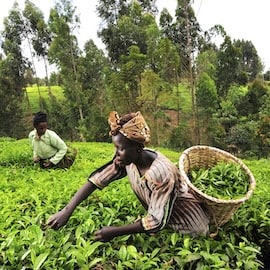For well over a decade, global development actors have deployed a suite of financial instruments and tools in hopes of unlocking commercial capital for agriculture in Africa — and for good reason. Despite employing 65-70% of the population of the continent and contributing 20-40% of national GDPs, the sector receives less than 3% of Africa’s commercial credit overall. Some countries deploy as much as 12% of commercial credit, but Kenya — a larger and more mature financial market used as a case study in this article — deploys just 4%, and that share has hovered in the 3-4% range for decades.
If these commercial credit figures were the only measures governments and global development actors tracked, they might conclude that progress in agricultural finance in sub-Saharan Africa has been modest at best. But the needle has moved, though not far or fast enough. And subtle shifts in behavior and market dynamics may be underway beneath the surface that we have not yet learned to detect, but that we might be able to influence.
A 2024 NextBillion article from Dalberg on “Measuring Systems Change” proposed three measurement approaches organizations can use to spot movement in complex systems: measuring the rate and trajectory of change, the sentiment to act, and the organization’s influence on the most influential actors. Zooming out, these approaches highlight two core dimensions to focus on: the end goal and the actors whose behaviors affect that goal.
However, in agricultural finance — perhaps even more than in other sectors — a third dimension is essential: context. No actor operates in a vacuum, and agriculture by its nature is especially vulnerable to external forces. Rainfall, price volatility and shifts in government policies can all influence whether lending flows accelerate, stall or retreat. As a result, meaningful monitoring of systems change efforts in the agriculture sector must also account for these factors and how they evolve.
This article builds on Dalberg’s piece and proposes a set of metrics for tracking systems change in agricultural finance across three levels: system, institutional and contextual. Some of these metrics are field-tested; others are proposed for reflection and refinement. The article closes with thoughts on why this work is difficult, and what it might take to make systems tracking more used and more useful.
DIMENSION 1: TRACKING SYSTEM-LEVEL CHANGE IN AGRICULTURAL FINANCE
When assessing system-level shifts in agricultural finance, practitioners often focus on whether more capital is flowing into the sector. While this is an important lens, on its own it offers a limited view. Volume does matter, but so do the stability, adaptability and breadth of the system. This section presents six metrics that, together, can help build a more comprehensive view of systems change in the sector.
1. Agriculture’s Share of Total Lending
This is a common metric in agricultural finance, and for good reason. It offers a directional indicator of how seriously the financial system is treating agriculture as a strategic sector. But it also has well-known limitations: classification challenges, inconsistent reporting, and varying definitions of “agricultural lending” across institutions and markets. Nonetheless, even as a proxy, it is a critical metric to track.
2. Absolute Lending to Agriculture
This metric offers insights that the agricultural share of lending alone obscures. First, market size matters: Kenya’s 4% of commercial lending going to agriculture is nearly twice the volume of Uganda’s 11%. Further, a shrinking share of total lending with rising volume of absolute lending still means more capital for agriculture. To illustrate, agriculture’s share of lending in Kenya is roughly the same as it was a decade ago, but the sector is nearly twice as large as it was then. Conversely, a growing share during a contraction in total credit might reflect shifting lender priorities. Each scenario yields different implications for actors shaping the system.
3. Relative Sector Prominence
It is also useful to ask: How does agriculture compare to other prominent sectors? Especially in countries where manufacturing, trade and services tend to dominate credit portfolios, tracking agriculture’s relative prominence helps situate it in the broader capital landscape. Is agriculture constantly lagging, or does it compete with big-hitter sectors over time? In a region where agriculture underpins both livelihoods and food security, its position relative to other sectors is worth understanding and addressing.
4. Multi-Year Rate of Change
Rather than focusing on annual growth, it is more useful to assess the rate of change over multi-year periods; for example, across three to five-year windows. One year of stagnation may mask progress underneath, and one spike may reflect a blip rather than a sustained increase in lending. A multi-year view helps zoom out from short-term volatility to capture systemic shifts in lender appetite.
5. Year-on-Year Volatility / Resilience
Volatility captures how sharply agricultural lending rises or falls year on year. Understanding the frequency, severity and persistence of these fluctuations can shed light on seemingly stagnant indicators and also reveal how resilient the system is to shocks and to the withdrawal of support mechanisms.
In Kenya, depending on what three or five-year cycle you track, the trend line for volume or agriculture share of lending might look like a zigzag. In those periods, it would be helpful to explore whether the fluctuations are less frequent, less sharp and shorter in duration than they used to be.
Tracking volatility also provides insight into the stability of the system in the face of adverse conditions, such as global downturns or climate shocks. We may be able to assess how a given shock influences the baseline level of volatility in the system, and the rate and quality of recovery compared to the past.
Finally, for practitioners, this metric could help inform when and how to gradually phase out interventions: Does the shape of the system change dramatically once phase-out begins? Is there a snapping back to the status quo, and if so, how quickly does it happen?
With this metric, we can go beyond merely observing that volatility occurred to understanding the system’s ability to absorb shocks over time. This offers far more insight into system health than the information provided by metrics for raw growth alone.
6. Density
Finally, it is also beneficial to ask: Who and how many are participating? A system where only a few actors are consistently lending to the agriculture sector, even at scale, may still be fragile. Seeing more “dots on the board” is one indicator of systems change. Imagine this scenario: Ten years ago, only three lenders in a given country were deploying capital to agriculture. Today, eight are. Not all are lending at scale, but more institutions are in the game. That yields a more robust system.
To assess density, organizations should ask: Is agricultural lending expanding beyond a few committed actors? What percentage of lenders deploy at least a certain volume of capital or percentage of their portfolio to the sector each year?
DIMENSION 2: TRACKING INSTITUTIONAL BEHAVIOR TO UNDERSTAND SYSTEMS CHANGE
System-level indicators help us track the big picture: capital flows, volatility patterns and the prevalence of different actors. But systems do not shift in abstraction: They shift because institutions, individually and collectively, begin to act differently.
The following institution-level metrics track not only what lenders do, but also what they believe, how they evolve and whether their actions last. In essence, they reveal whether lenders are becoming more confident, more experienced and more committed to agriculture, even when changes in headline numbers remain modest.
1. Perception (akin to Dalberg’s Sentiment to Change)
Perception can signal future behavior. Do lenders see agriculture as strategic or marginal, risky or promising? Perception does not materialize out of thin air — it is often shaped by portfolio performance, e.g., non-performing loans (NPLs) the previous year, competitor actions and other external factors. But it can still predict openness to change.
2. Portfolio Growth
Tracking portfolio shifts at the institution level tells us whether meaningful change is taking root within an organization, and may also illuminate internal obstacles to growth. For example, if perception is positive but portfolio growth is modest or non-existent, it could suggest that internal leaders or teams are not fully on board, or that internal structures are not yet in place to act.
3. Portfolio Diversification
Is agricultural lending concentrated in one or two “safe” value chains? A growing portfolio that remains narrowly focused may reflect risk aversion or shallow learning. This is the norm in East Africa, especially among larger financial institutions, as some value chains and borrower types are objectively easier to lend to. Diversification, especially into less favored segments, helps parse out genuine structural shifts from fortuitous growth.
4. Effort Institutionalization
Some institutions cycle through pilot programs without ever pursuing any of them in the longer term, simply because they can spare the resources to do so. As a result, they never embed pilot results into their core business. Experimentation can be a double-edged sword: a facade for real behavior change. As in any sector where incentives for development actors and sector players are misaligned, agriculture is susceptible to this sort of surface-level experimentation.
To bypass this, organizations could ask: Is agriculture an area where the institution is perpetually engaged in directionless experimentation, or is it actively integrating pilot results into its core programming? And who internally is paying attention?
5. Proactiveness
Finally, let’s look at a less visible signal: Is the institution self-driven, or is it only acting under pressure from regulators or development sector partners? Do institutions only act when funding incentives or government mandates are present, or do they deepen their activities in the sector on their own? If the engine is turning without external grease, that too is a signal of systems change.
DIMENSION 3: INTERPRETING (NOT TRACKING) CONTEXTUAL FORCES
Even the most committed institutions operate within a broader set of forces — some enabling, some constraining. To understand why systems stall or move, we also need to pay attention to the context they operate in.
Contextual forces are market-specific, which makes this dimension less suited to static indicators and more reliant on careful observation and interpretation. One challenge is knowing which contextual cues actually matter and how they will behave over time.
For instance, one might assume that rainfall patterns — an important contextual force in a region where agriculture is predominantly rain-fed — would have a strong, predictable impact on agricultural lending. But Kenya’s data suggests otherwise. Bank appetite for agricultural lending tends to shift slowly, showing cautious responsiveness to positive performance in the sector. Even after years of strong agro-ecological performance (e.g., good rains) or low levels of non-performing loans, lending to agriculture typically grows at a slower pace than lending to other sectors. In other words, the upside remains capped: Good years do not significantly accelerate capital flows to agriculture the following year. By contrast, the downside response is much sharper. Poor rainfall often triggers a spike in NPLs, which then leads to rapid contractions in lending. In short, positive fundamentals seem to rarely unlock dramatic increases in capital, but negative fundamentals quickly constrain it.
This asymmetric response highlights how contextual forces do not always behave in ways we assume, and may occasionally be overridden by decision factors within lending institutions. For organizations seeking to influence systems, understanding the totality of forces impacting these systems is essential. However, even once those forces are identified, one may find that they behave in indirect ways, they do not behave as one might expect, or their magnitude and impact change over time. Even so, these forces must be observed. Without this layer of insight, it is impossible to see where interventions can take hold, and where their limits will lie.
TRACKING WHAT MATTERS WHEN MEASURING SYSTEMS CHANGE
Estimates based on public data suggest that over the past decade more than $15 billion has been deployed into agriculture in East Africa, part of a broader effort to unlock commercial capital for the sector. With this level of effort and capital at play, the question isn’t just whether we are doing enough; it is also whether we are tracking what’s changing and where influence is taking root.
Measuring systems change is difficult, but there may be more practical metrics at our disposal than we realize. We should be prepared to look beyond the zigzags, stagnations and even contractions that may occur in some years, in search of other signals that things may be shifting. And while the examples in this article are drawn from agriculture, the underlying logic is sector-agnostic. If we want systems to evolve, we must deeply understand where their levers of change are, along with their patterns, relationships and limitations.
Lastly, we should be careful not to conflate individual program results with system shifts. True systems tracking should not rely on frameworks that only one organization can interpret. Proprietary methodologies that are only usable by a single organization have their place, but they should use or be complemented by data that is widely accessible in the outside world, and focus on making that data more meaningful. Otherwise, we risk mistaking isolated success stories for sector-wide change.
For those working in agriculture, what other signals could we assess to measure systems change in agricultural finance? For those outside of the sector, have you found effective ways to track systems change in your work?
Carla Legros is an independent consultant and strategist in agricultural and inclusive finance.
Photo credit: ©2010CIAT/NeilPalmer
Publisher: Source link






